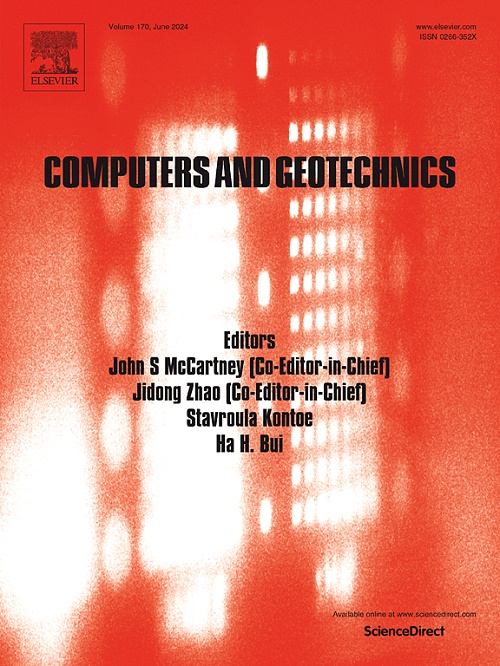Thermodynamics-based bounding surface model for gas hydrate-bearing sediments and its numerical implementation
IF 5.3
1区 工程技术
Q1 COMPUTER SCIENCE, INTERDISCIPLINARY APPLICATIONS
引用次数: 0
Abstract
In-depth research on the mechanical properties and constitutive models of gas hydrate-bearing sediments (GHBSs) is fundamental for achieving efficient hydrate exploration and geological disaster prevention. In the current study, a bounding surface model for GHBSs is developed based on the principle of thermodynamics. By choosing an appropriate dissipation function and free energy function, a yield surface function containing three shape parameters can be obtained. Considering the filling and bonding effects of hydrates, and introducing the hydrate strength evolution parameter, a thermodynamics-based bounding surface model for GHBSs is established using a non-associated flow rule. Then, the explicit substeping scheme with error control is implemented to develop a UMAT subroutine for the proposed model and integrated into the ABAQUS. Compared with the drained monotonic triaxial shear data indicates that the proposed model can adequately capture the shear behaviors of sandy, silty sandy, and clay-silty GHBSs under different stress levels and saturations. In addition, the model demonstrates good applicability and feasibility in undrained cyclic triaxial shear tests and boundary value problem analysis.
基于热力学的含天然气水合物沉积物边界面模型及其数值实现
深入研究含天然气水合物沉积物的力学特性和本构模型,是实现高效水合物勘探和地质灾害防治的基础。本研究基于热力学原理,建立了GHBSs的边界面模型。通过选择合适的耗散函数和自由能函数,可以得到包含三个形状参数的屈服面函数。考虑水合物的填充和粘结作用,引入水合物强度演化参数,采用非关联流动规则建立了基于热力学的GHBSs边界面模型。然后,采用带有误差控制的显式子步进方案,为所提出的模型开发UMAT子程序,并将其集成到ABAQUS中。与排水单调三轴剪切数据对比表明,该模型能较好地反映不同应力水平和饱和度下砂质、粉质砂质和粘土-粉质GHBSs的剪切特性。此外,该模型在不排水循环三轴剪切试验和边值问题分析中具有良好的适用性和可行性。
本文章由计算机程序翻译,如有差异,请以英文原文为准。
求助全文
约1分钟内获得全文
求助全文
来源期刊

Computers and Geotechnics
地学-地球科学综合
CiteScore
9.10
自引率
15.10%
发文量
438
审稿时长
45 days
期刊介绍:
The use of computers is firmly established in geotechnical engineering and continues to grow rapidly in both engineering practice and academe. The development of advanced numerical techniques and constitutive modeling, in conjunction with rapid developments in computer hardware, enables problems to be tackled that were unthinkable even a few years ago. Computers and Geotechnics provides an up-to-date reference for engineers and researchers engaged in computer aided analysis and research in geotechnical engineering. The journal is intended for an expeditious dissemination of advanced computer applications across a broad range of geotechnical topics. Contributions on advances in numerical algorithms, computer implementation of new constitutive models and probabilistic methods are especially encouraged.
 求助内容:
求助内容: 应助结果提醒方式:
应助结果提醒方式:


